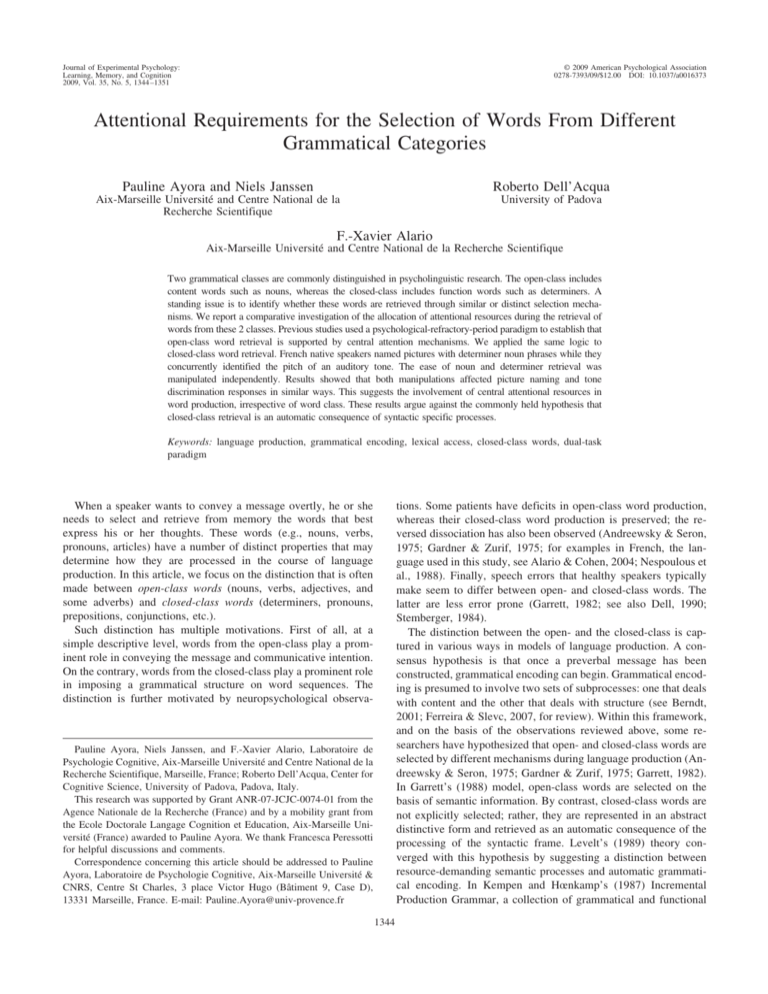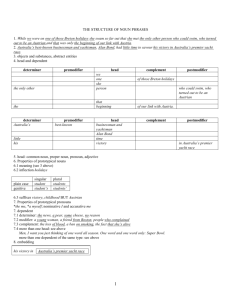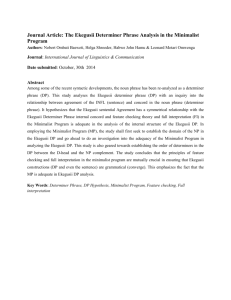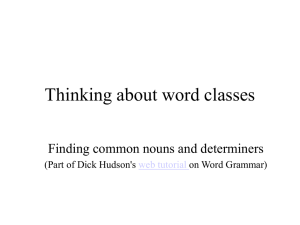Attentional Requirements for the Selection of Words From Different
advertisement

Journal of Experimental Psychology: Learning, Memory, and Cognition 2009, Vol. 35, No. 5, 1344 –1351 © 2009 American Psychological Association 0278-7393/09/$12.00 DOI: 10.1037/a0016373 Attentional Requirements for the Selection of Words From Different Grammatical Categories Pauline Ayora and Niels Janssen Roberto Dell’Acqua Aix-Marseille Université and Centre National de la Recherche Scientifique University of Padova F.-Xavier Alario Aix-Marseille Université and Centre National de la Recherche Scientifique Two grammatical classes are commonly distinguished in psycholinguistic research. The open-class includes content words such as nouns, whereas the closed-class includes function words such as determiners. A standing issue is to identify whether these words are retrieved through similar or distinct selection mechanisms. We report a comparative investigation of the allocation of attentional resources during the retrieval of words from these 2 classes. Previous studies used a psychological-refractory-period paradigm to establish that open-class word retrieval is supported by central attention mechanisms. We applied the same logic to closed-class word retrieval. French native speakers named pictures with determiner noun phrases while they concurrently identified the pitch of an auditory tone. The ease of noun and determiner retrieval was manipulated independently. Results showed that both manipulations affected picture naming and tone discrimination responses in similar ways. This suggests the involvement of central attentional resources in word production, irrespective of word class. These results argue against the commonly held hypothesis that closed-class retrieval is an automatic consequence of syntactic specific processes. Keywords: language production, grammatical encoding, lexical access, closed-class words, dual-task paradigm tions. Some patients have deficits in open-class word production, whereas their closed-class word production is preserved; the reversed dissociation has also been observed (Andreewsky & Seron, 1975; Gardner & Zurif, 1975; for examples in French, the language used in this study, see Alario & Cohen, 2004; Nespoulous et al., 1988). Finally, speech errors that healthy speakers typically make seem to differ between open- and closed-class words. The latter are less error prone (Garrett, 1982; see also Dell, 1990; Stemberger, 1984). The distinction between the open- and the closed-class is captured in various ways in models of language production. A consensus hypothesis is that once a preverbal message has been constructed, grammatical encoding can begin. Grammatical encoding is presumed to involve two sets of subprocesses: one that deals with content and the other that deals with structure (see Berndt, 2001; Ferreira & Slevc, 2007, for review). Within this framework, and on the basis of the observations reviewed above, some researchers have hypothesized that open- and closed-class words are selected by different mechanisms during language production (Andreewsky & Seron, 1975; Gardner & Zurif, 1975; Garrett, 1982). In Garrett’s (1988) model, open-class words are selected on the basis of semantic information. By contrast, closed-class words are not explicitly selected; rather, they are represented in an abstract distinctive form and retrieved as an automatic consequence of the processing of the syntactic frame. Levelt’s (1989) theory converged with this hypothesis by suggesting a distinction between resource-demanding semantic processes and automatic grammatical encoding. In Kempen and Hœnkamp’s (1987) Incremental Production Grammar, a collection of grammatical and functional When a speaker wants to convey a message overtly, he or she needs to select and retrieve from memory the words that best express his or her thoughts. These words (e.g., nouns, verbs, pronouns, articles) have a number of distinct properties that may determine how they are processed in the course of language production. In this article, we focus on the distinction that is often made between open-class words (nouns, verbs, adjectives, and some adverbs) and closed-class words (determiners, pronouns, prepositions, conjunctions, etc.). Such distinction has multiple motivations. First of all, at a simple descriptive level, words from the open-class play a prominent role in conveying the message and communicative intention. On the contrary, words from the closed-class play a prominent role in imposing a grammatical structure on word sequences. The distinction is further motivated by neuropsychological observa- Pauline Ayora, Niels Janssen, and F.-Xavier Alario, Laboratoire de Psychologie Cognitive, Aix-Marseille Université and Centre National de la Recherche Scientifique, Marseille, France; Roberto Dell’Acqua, Center for Cognitive Science, University of Padova, Padova, Italy. This research was supported by Grant ANR-07-JCJC-0074-01 from the Agence Nationale de la Recherche (France) and by a mobility grant from the Ecole Doctorale Langage Cognition et Education, Aix-Marseille Université (France) awarded to Pauline Ayora. We thank Francesca Peressotti for helpful discussions and comments. Correspondence concerning this article should be addressed to Pauline Ayora, Laboratoire de Psychologie Cognitive, Aix-Marseille Université & CNRS, Centre St Charles, 3 place Victor Hugo (Bâtiment 9, Case D), 13331 Marseille, France. E-mail: Pauline.Ayora@univ-provence.fr 1344 RESEARCH REPORTS procedures do their work automatically,1 without taxing the speaker’s attentional resources, and in a parallel fashion. Of note, however, are certain indications that at least some grammatical operations may be sensitive to central processing demands. In particular, Fayol, Largy, and Lemaire (1994) reported that cognitive overload (i.e., completing a distracting task) increased the rate of subject–verb agreement errors during offline written sentence production. In recent years, determiners (e.g., the, or in gender-marked languages such as French, le/la) have emerged as an important test case for understanding closed-class word retrieval and its relation to syntactic processing. In many languages, determiner retrieval depends not only on semantic information but also on information such as the grammatical gender and the phonological properties of the context. Furthermore, these features can converge on a single determiner form or favor various determiner forms (see Table 1 for examples). It has been repeatedly observed that naming latencies depend on the congruency among these different features (e.g., Alario, Ayora, Costa, & Melinger, 2008; Alario & Caramazza, 2002; Janssen & Caramazza, 2003; Schriefers, Jescheniak, & Hantsch, 2002; Spalek & Schriefers, 2005; an example of such a manipulation is described and used below). Although research on determiner production has been inspired by the syntactic models described above, it has adopted a more lexicalist view when accounting for the experimental data. Despite disagreements concerning certain aspects of the activation and selection process, the congruency effect has been attributed to the ease of retrieval of determiner forms (e.g., the possessive /mõ/, my, or the demonstrative /sEt/, this, in French) and is thought to be driven primarily by linguistic information (e.g., gender and phonology). Despite these proposals, the precise differences and similarities between word retrieval mechanisms for the two classes are largely unknown. In particular, the mechanisms involved in processing closed-class words and integrating them into a developing syntactic structure remain unclear. One experimental approach that seems appropriate to test the hypothesis of distinct processes for open- and closed-class word retrieval comes from the psychological refractory period (PRP) paradigm. In this paradigm, two stimuli (S1 and S2) are presented at short stimulus onset asynchronies (SOAs), and each stimulus is associated with a distinct choice reaction time task (Task 1 and Task 2). One of the two tasks is chosen to engage central attention mechanisms, that is, domaingeneral mechanisms shared among distinct and unrelated tasks. Previous research has established that central attention mechanisms are engaged in various mental operations such as response selection (Pashler & Johnston, 1998), mental rotation (Van Selst & Jolicœur, 1994), and short-term memory consolidation (Dell’Acqua & Jolicœur, 2000; Jolicœur & Dell’Acqua, 1998). The logic behind the use of the PRP paradigm is based on the assumption that central mechanisms operate serially on stimuli presented sequentially. This is in contrast with other mechanisms, generally referred to as precentral and postcentral, which are thought to occur automatically (i.e., they can occur in parallel with any other stage of the other task) and which may be domain specific (i.e., they are concerned only with certain types of mental representation, e.g., sensorial and motor representations; see Tombu & Jolicœur, 2003). A set of highly distinctive predictions can be generated on the basis of this logic. One prediction is that some form of interference must be 1345 detected in either one or both tasks when the execution of certain stages of both tasks requires central mechanisms (e.g., see Pashler, 1994, for a comprehensive review). Another prediction is that if both tasks require central mechanisms, manipulations affecting central or precentral stages of processing in Task 1 (e.g., prolonging Response Time 1 [RT1] by a certain amount) should prolong the time taken to carry out Task 2 (RT2) by a corresponding amount. In contrast, if Task 1 processing does not require central mechanisms but instead relies on a domain-specific mechanism, then a manipulation affecting its processing should not have any influence on the processing of Task 2. This is because both tasks could be processed independently. Finally, because postcentral stages of processing in Task 1 are hypothesized to be carried out in parallel with any other stages of Task 2, manipulations affecting these late stages should not have any influence on RT2. The two last predictions are used to motivate the experiment reported below. In the area of language production, Ferreira and Pashler (2002) reported two PRP experiments to assess mechanisms involved in open-class selection. Task 1 was picture naming, used to elicit lexical retrieval processes. The ease of target noun retrieval was manipulated with a standard procedure contrasting naming times to high and low lexical frequency items. Task 2 was an auditory discrimination task in which participants had to identify the pitch (low, medium, or high) of a tone. The lexical frequency manipulation produced a significant slowdown effect of 60 ms in Task 1. The results in Task 2 were just as clear. Participants were 74 ms slower to identify the pitch of a tone when naming a picture with a low frequency name than one with a high frequency name. In accordance with the logic presented above, these results indicate that the lexical frequency manipulation implemented in Task 1 affected central or precentral stages of processing. In other words, the central mechanisms needed for the completion of the second task could not be engaged while participants were selecting the target noun. The conclusion that central processing is engaged during lexical selection for open-class words was confirmed and further clarified by Dent, Johnston, and Humphreys (2008). The attentional requirements of postlexical phonological processing have also been investigated with the classical PRP paradigm. Cook and Meyer (2008) reported that a manipulation of phonological retrieval in picture naming (Task 1) propagated to tone discrimination (Task 2) reaction times. This was interpreted as evidence that phoneme selection during open-class production also engages central processing. The conclusions regarding the involvement of central processing during open-class selection cannot be generalized straightforwardly to the closed class. This is because of the differences mentioned above between open- and closed-class words and the hypotheses that have been proposed to account for these differences. At this point, however, a tentative connection between the language and attentional frameworks can be proposed (a more elaborate connection will be proposed in the Discussion section). 1 When used to refer to a specific functional subroutine, automatic and automatically are terms that must be intended operationally, as indicating processing that (a) should not impinge on general purpose, control/ attention mechanisms that are held to be shared, under particular circumstances, between distinct tasks; (b) may be hypothesized to be, in this specific interpretative framework, devoid of attentional cost. RESEARCH REPORTS 1346 Table 1 Examples of French Possessive and Demonstrative Determiners Used in the Phonological Contexts Following word Consonant Determiner Gender noun Determiner form Masc Fem Masc Fem /mõ/ /ma/ /se/ /sEt/ Mon piano Ma table Ce piano Cette table My piano My table This piano This table Masc Fem Masc Fem /mõ/ /mõ/ /sEt/ /sEt/ Mon arbre Mon étoile Cet arbre Cette étoile My tree My star This tree This star Possessive Fem Demonstrative Masc /mõ/ /ma/ /sEt/ /se/ Mon ancienne table Ma nouvelle étoile Cet ancien piano Ce nouvel arbre My old table My new star This old piano This new tree Possessive Demonstrative Vowel Possessive Demonstrative Vowel Consonant Vowel Consonant Example Gloss Condition — — — — Congruent Incongruent Incongruent Congruent — — — — Note. When the following word is consonant-initial, grammatical gender agreement rules apply. When the following word is vowel-initial, phonology supersedes grammatical gender agreement, and a single determiner form is used for both masculine and feminine nouns. With prenominal adjectives, the same rules apply, showing that there is no one-to-one mapping between noun and determiner form. The orthographic forms cet and cette are homophonous and are understood as having a single underlying representation. The experimental manipulation of congruency concerned vowel-initial nouns (see middle section of table). Masc ⫽ masculine; Fem ⫽ feminine. If, in some strong sense, closed-class words do not have to be selected and are processed as an integral part of the syntactic frame (e.g., Garrett, 1988; see discussion above), it is not obvious that their retrieval engages central resources. Moreover, if closed-class word retrieval is carried out by language-dedicated processes, slowing this retrieval should not affect performance in the second task. In the experiment reported here, we tested whether the retrieval of words from the two grammatical classes differs in terms of attentional resources required. In Task 1, participants had to name pictures with determiner noun phrases (NPs) composed of a closed-class word (a determiner) and an open-class word (a noun). For example, participants produced the French equivalent of my table. In the concurrent Task 2, they had to identify the pitch of an auditory tone. The ease of open- and closed-class word selection was manipulated independently. Noun retrieval was manipulated through lexical frequency. On the basis of the previously established conclusion that open-class selection requires central processing (Dent et al., 2008; Ferreira & Pashler, 2002), we expected to observe the lexical frequency effect for nouns in Task 1 to propagate onto Task 2. The ease of determiner retrieval was manipulated with a congruency manipulation previously reported for French possessive and demonstrative determiners (Alario & Caramazza, 2002). As noted above, French and other Romance determiner forms depend on the grammatical gender (masculine or feminine) of the corresponding noun and on the phonological properties (consonantinitial or vowel-initial) of the immediately following word (see Table 1 for examples). Critical for our experiment are cases in which the determiner is followed by a vowel-initial noun. These nouns allow defining NPs with congruent and incongruent determiners, where congruency concerns the association of grammatical gender and determiner form. Masculine nouns used with a possessive and feminine nouns used with a demonstrative are referred to as congruent NPs because the association of grammatical gender and determiner form coincides with that of the default consonant case. Conversely, feminine nouns used with a possessive and masculine nouns used with a demonstrative are referred to as incongruent NPs because of a reversed gender-determiner form association. In this way, congruency is defined within items. Alario and Caramazza (2002) compared speakers’ performance with congruent and incongruent determiners. They observed longer naming latencies for incongruent than for congruent determiners, a result that was taken to reveal slower determiner form retrieval. This determiner retrieval manipulation was used in the experiment reported below, to test its effect on a secondary unrelated task. The congruency manipulation was predicted to delay determiner form retrieval in Task 1. The propagation of this effect to Task 2 depends on the hypothesis adopted regarding determiner retrieval mechanisms. If determiner form retrieval engages central mechanisms, then slower performance in the incongruent condition of Task 1 should lead to slower performance in Task 2. By contrast, failing to observe such propagation would be consistent with a language-dedicated mechanism of determiner form retrieval, in line with the hypothesis of automatic closed-class word processing. Method Participants Sixty undergraduate students at the Université de Provence (Aix en Provence, France) participated in the experiment. Participants received course credit for participation. All reported having learned French as their first language and having no language or hearing disturbance. Materials We selected 104 black and white pictures of common objects from a French database (Alario & Ferrand, 1999). All of these RESEARCH REPORTS pictures were to be named with two different determiner forms: a possessive form (/mõ/-/ma/) and a demonstrative one (/se/-/sEt/). Among these materials, 78 pictures with consonant-initial names were used to manipulate noun retrieval. Half had a masculine name, and the other half had a feminine name. They were selected on a continuous range of lexical frequency, from 0.1 to 300 occurrences per million, as estimated by Lexique (New, Pallier, Ferrand, & Matos, 2001). The groups of picture names below and above median frequency were matched for word length (number of letters, number of phonemes, and number of syllables). The 26 other pictures had vowel-initial names and were used to manipulate determiner retrieval. Half of them had a feminine name, and the other half had a masculine name. Finally, we selected 8 training pictures from the same database. The stimuli for the tone task were 285-ms high-, medium-, and low-pitched pure tones (1,200, 500, and 180 Hz, respectively). Design All pictures had to be named in a dual-task context. Participants were engaged in a picture-naming task (Task 1) eliciting the production of an NP (determiner ⫹ noun). Concurrently, they had to identify the pitch of a tone (Task 2). The frequency manipulation (within participants, between items) concerned consonantinitial items. The congruency manipulation (within participants and items) concerned vowel-initial items. Possessive and demonstrative NPs were produced in two distinct blocks of 78 items each. Half of the participants started the experiment with the possessive block, and the other half started with the demonstrative block. Here (as in Alario & Caramazza, 2002; see examples in Table 1), vowel-initial feminine items used with a possessive determiner constituted incongruent trials (mon étoile [my starfeminine]), whereas the same items used with a demonstrative determiner constituted congruent trials (cette étoile [this starfeminine]). Conversely, vowel-initial masculine items used with possessive determiners constituted congruent trials (mon arbre [my treemasculine]), whereas the same items used with a demonstrative determiner constituted incongruent trials (cet arbre [this treemasculine]). The use of possessive and demonstrative phrases allowed for the congruency manipulation to be within items. To balance the number of determiner forms produced during the experiment, 26 consonant-initial items (13 below and 13 above median frequency) were presented twice, once in each block. These repeated items were considered as fillers when in the second block (see Appendix for a complete presentation of the materials and their organization). Items within a block were pseudorandomized. The pitch of the tone varied randomly between trials, though each participant was presented with equal numbers of each pitch. The pitch–picture association was random. We created 20 possessive lists and 20 demonstrative lists. Each participant received one of each. Given the complex design, and to maximize the number of observations in the analyses, we used the unique value of 150 ms SOA, generally used to ensure that the execution of the two tasks overlapped.2 Apparatus and Procedure The experiment was controlled by the software DMDX (Forster & Forster, 2003), which recorded participants’ manual and vocal re- 1347 sponses. Software-estimated naming latencies were checked visually and adjusted manually if necessary with CheckVocal (Protopapas, 2007). Button press responses were measured with three buttons on a game pad. Participants were tested individually. Before the experiment proper, they were familiarized with the pictures and were asked to provide a name for them. They were corrected if they did not produce the intended name. Then they practiced 24 tone-discrimination trials (each pitch heard eight times). They were finally given 24 dual-task practice trials that were identical in structure to the experimental trials described below, but with the training pictures. During an experimental trial, participants saw a blank screen for 300 ms before it was replaced by a fixation point for 500 ms. The picture stimulus then appeared on the screen until the voice key detected a response. Participants were instructed to name it as quickly as possible using an NP (determiner ⫹ noun). The auditory stimulus for tone discrimination was presented 150 ms after picture onset. Participants were instructed to identify the pitch of the tone promptly, pressing the corresponding button, while still naming the picture as quickly as possible. They had to respond within an interval of 2 s after the picture onset. The complete session lasted approximately 45 min. Analysis Trials on which there was an error in the picture-naming task (4.1%) or in the tone-discrimination task (10.1%) were removed from RT analyses. This resulted in the removal of 12.4% of the trials. RTs in both tasks were log-transformed to approximate normal distributions. These distributions were fitted with linear mixed-effects models, with participants and items as crossed random effects (Baayen, Davidson, & Bates, 2008). Because the congruency and frequency manipulations were specific to different groups of items, we analyzed separately trials corresponding to consonant-initial items and those corresponding to vowel-initial items. Moreover, naming and tone-discrimination latencies were analyzed separately. For each contrast in the RT analysis, we report , the corresponding t value, and an estimated p. Error rates were analyzed with a logistic model that had the same structure as that used for RTs except that the data were collapsed across tasks. For each contrast, we report , the corresponding z value, and estimated p. Results Consonant-Initial Items (Noun Manipulation) Increased lexical frequency resulted in shorter picture-naming latencies,  ⫽ ⫺0.021, t(3940) ⫽ ⫺4.38, p ⬍ .001, and shorter tone-discrimination latencies,  ⫽ ⫺0.023, t(3940) ⫽ ⫺4.44, p ⬍ .001. The  proximity indicates a similar effect size in the two 2 The expedient of using a single—short—SOA (vs. the common practice of employing a varying SOA separating Task 1 and Task 2) was adopted in the present context to preserve the maximum magnitude of determiner selection difficulty effects on RT1 together with the maximum probability to observe full propagation of RT1 effects onto RT2. The manipulation of SOA is, indeed, naturally associated with stimuli repetition at each tested SOA, opening to the potential of detrimental effects related to increased stimulus familiarity (due to repetition) as the number of tested SOAs is increased. See Dell’Acqua, Sessa, Jolicœur, and Robitaille (2006) for the adoption of a similar solution in a different dual-tasking context. RESEARCH REPORTS 1348 tasks. Increased lexical frequency also resulted in lower error rates,  ⫽ ⫺1.85, z ⫽ ⫺9.77, p ⬍ .001. Vowel-Initial Items (Determiner Manipulation) NPs with incongruent determiners resulted in longer latencies than those with congruent determiners, both in the picture-naming task,  ⫽ 0.015, t(2663) ⫽ 2.21, p ⫽ .025, and in the tonediscrimination task,  ⫽ 0.016, t(2663) ⫽ 2.02, p ⫽ .040. Again, the  proximity indicates a similar effect size in the two tasks. Errors were equally distributed across incongruent and congruent trials,  ⫽ ⫺0.176, z ⫽ ⫺1.67, p ⫽ .094. In a second analysis of the latency data, congruency was broken into two factors: type of determiner and grammatical gender. The results showed significant interactions between these factors in the picture-naming task,  ⫽ ⫺0.029, t(2661) ⫽ ⫺2.17, p ⫽ .03, and in the tonediscrimination task,  ⫽ ⫺0.033, t(2661) ⫽ ⫺2.01, p ⫽ .04. These interactions indicate shorter latencies for possessive determiners associated with masculine nouns and for demonstrative determiners associated with feminine nouns (i.e., for the congruent conditions). The main effects of determiner type and grammatical gender were not computed; they are confounded with item groups (i.e., they involve different determiners or different nouns) and are therefore uninformative. The observed data, averaged across participants and experimental conditions, are presented in Table 2. The estimates of the model are presented in Figure 1. Discussion The goal of the present research was to compare the mechanisms involved in the retrieval of words belonging to different grammatical categories. To address this question, we assessed effects known to affect the retrieval of open- and closed-class words, probing their impact on a concurrent tone-discrimination task. Open-class retrieval was manipulated by means of noun lexical frequency; closed-class retrieval was manipulated by means of determiner congruency. The critical finding was that both manipulations affected picture-naming latencies (Task 1) and propagated onto tone-discrimination latencies (Task 2). In other words, tone discrimination latencies were strongly dependent on the efficiency in carrying out Task 1. The frequency manipulation and its consequences for tone discrimination latencies are in line with previous results (Dent et al., 2008; Ferreira & Pashler, 2002). This replication confirms the involvement of central mechanisms in noun retrieval. Moreover, it indicates that a PRP effect was successfully induced and supports the experimental strategy of comparing it with mechanisms involved in determiner retrieval. The novelty of our research resides in the propagation of the determiner congruency effect from the picture-naming task to the tone-discrimination task. There was a greater delay in tonediscrimination responses when participants produced an incongruent determiner relative to when they produced a congruent one. The  proximity in the Task 1 and Task 2 analyses indicates that congruency affected both tasks to the same extent, as predicted by language architectures hypothesized on the basis of PRP evidence (see Introduction). This finding constrains the locus of determiner processing within a PRP architecture. The propagation of the congruency effect clearly indicates that determiner retrieval is not located at a postcentral stage of processing. Otherwise, no propagation to tone-discrimination latencies should have been observed. Our observations, then, argue against the view that closed-class word retrieval involves automatic processes (e.g., Garrett, 1988; Levelt, 1989). Rather, the ms-by-ms congruency effect propagation suggests for the first time that determiner form retrieval “bottlenecked” a central stage of processing needed for the completion of Task 2. The nature of closed-class word retrieval can be further clarified within the PRP model on the basis of previously published data. According to the PRP logic, the pattern of results we report is consistent with both a precentral and a central locus of the congruency effect. This is because delaying a precentral or a central stage in Task 1 would delay the point at which central resources become available for the completion of Task 2. However, a strong argument can be raised against a precentral locus for the determiner congruency effect. The selection of the closed-class words we used is dependent on the retrieval of syntactic properties of the noun (e.g., grammatical gender). This information associated to the lexical representation level (e.g., Levelt, Roelofs, & Meyer, 1999) has been recently identified as requiring central processing (Dent et al., 2008; Ferreira & Pashler, 2002). Moreover, in Romance languages determiner selection is further delayed until the point where the noun’s phonology becomes available (Miozzo & Caramazza, 1999). This information associated with the phoneme selection level has also been identified as requiring central processing (Cook & Meyer, 2008). Because these central lexical and phoneme Table 2 Mean Naming Latencies (M) and Standard Deviations (SD), Both in Milliseconds, by Participants and Experimental Condition Picture naming Type of picture name Consonant initial picture name Low frequency Medium frequency High frequency Vowel initial picture name Incongruent Congruent Tone discrimination M Difference SD M Difference SD 1,019 969 945 — 50 24 69 63 69 1,128 1,072 1,038 — 56 34 63 64 72 962 945 — 17 65 52 1,076 1,057 — 19 74 66 Note. For this table only, lexical frequency was divided into three quantiles. RESEARCH REPORTS 1349 Figure 1. Estimated response latencies for the noun and the determiner manipulations across the two tasks. Similar effect sizes were observed in Task 1 (picture naming) and Task 2 (tone discrimination). Error bars represent the standard error around the congruency effect estimated in each task. selections are needed to select the determiner, a necessary conclusion is that determiner form retrieval cannot occur at a precentral stage. Thus, the available data from both determiner selection and language production in a dual-task context lead us to reject a postcentral as well as a precentral locus of determiner retrieval and to favor a central locus. This process involves the selection of an appropriate response under demands that are apparently similar to those that arise in a task such as tone discrimination (and openclass lexical access). Previous research had highlighted the central nature of the processes involved in noun production. Our results confirm this conclusion and expand it. Once a noun has been selected, domain-general central processing mechanisms are still needed to select the correct determiner form. In other words, determiner form retrieval cannot be considered to rely on language-dedicated mechanisms. This result by itself contradicts a general hypothesis of automaticity in closed-class retrieval; further research will have to test the validity of this conclusion for other closed-class words. References Alario, F.-X., Ayora, P., Costa, A., & Melinger, A. (2008). Grammatical and nongrammatical contributions to closed-class word selection. Journal of Experimental Psychology: Learning, Memory, and Cognition, 34, 960 –981. Alario, F.-X., & Caramazza, A. (2002). The production of determiners: Evidence from French. Cognition, 82, 179 –223. Alario, F.-X., & Cohen, L. (2004). Closed-class words in sentence production: Evidence from a modality-specific dissociation. Cognitive Neuropsychology, 21, 787– 819. Alario, F.-X., & Ferrand, L. (1999). A set of 400 pictures standardized for French: Norms for name agreement, image agreement, familiarity visual complexity, image variability, and age of acquisition. Behavior Research Methods Instruments and Computers, 31, 531–552. Andreewsky, E., & Seron, X. (1975). Implicit processing of grammatical rules in a classical case of agrammatism. Cortex, 11, 379 –390. Baayen, R. H., Davidson, D. J., & Bates, D. M. (2008). Mixed-effects modeling with crossed random effects for subjects and items. Journal of Memory and Language, 59, 390 – 412. Berndt, R. S. (2001). Sentence production. In B. Rapp (Ed.), The handbook of cognitive neuropsychology: What deficits reveal about the human mind (pp. 375–396). Hove, England: Psychology Press. Cook, A. E., & Meyer, A. S. (2008). Capacity demands of phoneme selection in word production: New evidence from dual-task experiments. Journal of Experimental Psychology: Learning, Memory, and Cognition, 34, 886–899. Dell, G. S. (1990). Effects of frequency and vocabulary type on phonological speech errors. Language and Cognitive Processes, 4, 313–349. Dell’Acqua, R., & Jolicœur, P. (2000). Visual encoding of patterns is subject to dual-task interference. Memory & Cognition, 28, 184 –191. Dell’Acqua, R., Sessa, P., Jolicœur, P., & Robitaille, N. (2006). Spatial attention freezes during the attentional blink. Psychophysiology, 43, 394 – 400. Dent, K., Johnston, R. A., & Humphreys, G. W. (2008). Age of acquisition and word frequency effects in picture naming: A dual-task investigation. Journal of Experimental Psychology: Learning, Memory, and Cognition, 34, 282–301. Fayol, M., Largy, P., & Lemaire, P. (1994). Cognitive overload and orthographic errors: When cognitive overload enhances subject-verb agreement errors. A study in French written language. The Quarterly Journal of Experimental Psychology, 47A, 437– 464. Ferreira, V. S., & Pashler, H. (2002). Central bottleneck influences on the processing stages of word production. Journal of Experimental Psychology: Learning, Memory, and Cognition, 28, 1187–1199. Ferreira, V. S., & Slevc, L. R. (2007). Grammatical encoding. In M. Gareth Gaskell (Ed.), The Oxford handbook of psycholinguistics (pp. 453– 469). Oxford, England: Oxford University Press. Forster, K. I., & Forster, J. C. (2003). A Windows display program with millisecond accuracy. Behavior Research Methods Instruments and Computers, 35, 116 –124. Gardner, H., & Zurif, E. (1975). Bee but not be: Oral reading of single words in aphasia and alexia. Neuropsychologia, 13, 181–190. Garrett, M. F. (1982). Production of speech: Observations from normal and RESEARCH REPORTS 1350 pathological language use. In A. Ellis (Ed.), Normality and pathology in cognitive functions (pp. 19 –76). London: Academic Press. Garrett, M. F. (1988). Processes in language production. In F. J. Newmeyer (Ed.), Language: Psychological and biological aspects (pp. 69 –96). New York: Cambridge University Press. Janssen, N., & Caramazza, A. (2003). Selection of closed-class words in noun phrase production: The case of Dutch determiners. Journal of Memory and Language, 48, 635– 652. Jolicœur, P., & Dell’Acqua, R. (1998). The demonstration of short-term consolidation. Cognitive Psychology, 36, 138 –202. Kempen, G., & Hœnkamp, E. (1987). An incremental procedural grammar for sentence formulation. Cognitive Science, 11, 201–258. Levelt, W. J. M. (1989). Speaking: From intention to articulation. Cambridge, MA: MIT Press. Levelt, W. J. M., Roelofs, A., & Meyer, A. S. (1999). A theory of lexical access in speech production. Behavioural and Brain Sciences, 22, 1–75. Miozzo, M., & Caramazza, A. (1999). The selection of determiners in noun phrase production. Journal of Experimental Psychology: Learning, Memory, and Cognition, 25, 907–922. Nespoulous, J. L., Dordain, M., Perron, C., Ska, B., Bub, C., Caplan, D., et al. (1988). Agrammatism in sentence production without comprehension deficits: Reduced availability of syntactic structures and/or of grammatical morphemes? A case study. Brain and Language, 33, 273–295. New, B., Pallier, C., Ferrand, L., & Matos, R. (2001). A lexical database for contemporary French on the Internet: Lexique. Année Psychologique, 101, 447– 462. Pashler, H. (1994). Dual-task interference in simple tasks: Data and theory. Psychological Bulletin, 116, 220 –244. Pashler, H., & Johnston, J. C. (1998). Attentional limitations in dual-task performance. In H. Pashler (Ed.), Attention (pp. 155–189). Hove, England: Psychology Press. Protopapas, A. (2007). CheckVocal: A program to facilitate checking the accuracy and response time of vocal responses from DMDX. Behavior Research Methods, 39, 859 – 862. Schriefers, H., Jescheniak, J. D., & Hantsch, A. (2002). Determiner selection in noun phrase production. Journal of Experimental Psychology: Learning, Memory, and Cognition, 28, 941–950. Spalek, K., & Schriefers, K. (2005). Dominance affects determiner selection in language production. Journal of Memory and Language, 52, 103–119. Stemberger, J. P. (1984). Structural errors in normal speech and agrammatic speech. Cognitive Neuropsychology, 1, 281–313. Tombu, M., & Jolicœur, P. (2003). A central capacity sharing model of dual task performance. Journal of Experimental Psychology: Human Perception and Performance, 29, 3–18. Van Selst, M., & Jolicœur, P. (1994). Can mental rotation occur before the dual-task bottleneck? Journal of Experimental Psychology: Human Perception and Performance, 20, 905–921. Appendix Material and Design Possessive block Letter-initial Vowel Noun aquarium arrosoir entonnoir éclair arbre avion igloo arc oiseau ongle ail oeil oeuf assiette écharpe enveloppe échelle équerre étoile hélice orange oreille usine ancre aile oie bouéea cagea clefa chaussettea Gender Masculine Determiner status Demonstrative block Determiner form Congruent mon Feminine Incongruent Noun aquarium arrosoir entonnoir éclair arbre avion igloo arc oiseau ongle ail oeil oeuf assiette écharpe enveloppe échelle équerre étoile hélice orange oreille usine ancre aile oie bouéea cagea clefa chaussettea Gender Determiner status Masculine Incongruent Determiner form set Feminine Congruent RESEARCH REPORTS 1351 Appendix (continued) Possessive block Letter-initial Noun chaisea fenêtrea feuillea girafea lampea passoirea pellea seringuea valisea Consonant banjoa bola chapeaua chata livrea lita poivrona poulpea siffleta téléphonea tonneaua violona verrea boussole bague bouche cravate carotte cheminée chemise fleur fraise girouette louche luge montagne maison niche pastèque poubelle plume pomme robe ceinture scie télévision table toupie vache a Gender Determiner status Feminine Demonstrative block Determiner form chaisea fenêtrea feuillea girafea lampea passoirea pellea seringuea valisea ma Standard Masculine Feminine Noun mon ma banjoa bola chapeaua chata livrea lita poivrona poulpea siffleta téléphonea tonneaua violona verrea ballon cactus cadenas canoë crayon clown couteau coeur château chignon dinosaure gland landau miroir nuage pantalon piano poisson râteau soleil cintre sac ski train voilier zèbre Gender Determiner status Feminine Determiner form set Standard Masculine ce Masculine Consonant-initial nouns considered as filler during the second presentation (here in the demonstrative block). Received December 15, 2008 Revision received March 16, 2009 Accepted March 19, 2009 䡲







